Żywiec
The next day the sun was shining in a clear blue sky, quite a difference compared with the previous day.
In the morning we went to Żywiec, a town not far from Kalna and known for its brewery where the famous Polish beer with the same name is brewed.
On Wednesday there is a local market in Żywiec where all kind of products can be bought. There is also some livestock for sale like chickens,
piglets, calves, rabbits etc. When you buy a small animal like e.g. a rabbit, you'll receive in a plastic bag. So on the market you will see a lot of
people walking with a moving plastic bag containing a rabbit or a chicken. From the market we drove on to the centre of Żywiec to see the
most important sights of the town. In the park we went to the castle, a bit rundown, it definitely needs to be restored. In the castle there was an
exhibition about spiders and scorpions which we visited. Luckily most of these creepy creatures were caged. At the entrance, the boy that sold the
tickets had a tarantula spider walking around on his desk. Visitors were allowed to stroke it or to put the spider on their hand. Ciska and Hilleke
didn't like the idea of doing that, but Arjan indeed had the spider on his hand and stroke it. This gave Ciska and Hilleke the creeps. After the
exhibition we walked through the centre of the town and had something to eat on the central square before we went back to Kalna.
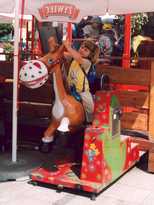
Ciska on the central square in Żywiec
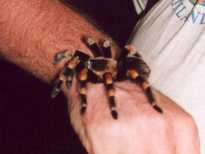
Tarantula spider on Arjan's hand
Auschwitz
A visit to Auschwitz is not the most fun excursion during a holiday, but when you are so nearby you can not ignore such an important piece of
human history. So after our visit in the morning to Żywiec we drove in the afternoon towards Oświęcim, the place of the former concentration camp
Auschwitz-Birkenau. We left Ciska this afternoon with Gerda because a visit to Auschwitz is not suitable for a five-year old girl. At the entry of the
former concentration camp there is also a sign saying: "Children below the age of 14 do not belong here", although it is not forbidden. In all of the world,
Auschwitz has become the symbol of the terror and genocide of the Nazis in the Second World War. It is the largest murder-factory in the history of mankind.
You enter the camp through the gate with the cynical text "Arbeit Macht Frei" (Labour Liberates). In a number of the former, rebuild, barracks there are
exhibitions showing all what happened in the camp during the war. The walls of the corridors in the barracks are full with thousands of pictures with the
names of the victims. Very impressive was also the room with hundreds of suitcases bearing the name and sometimes birth date and residence of its owner. There
is also a room with thousands of shoes, from small child's shoes to wooden shoes. A room containing thousands of hairbrushes, shaving-brushes, toothbrushes, etc.
All personal belongings of people that died a cruel death in this camp. It is really unimaginable. Beneath some of the barracks there are long corridors with
prison cells to lock up the people that were condemned to death . There are also 'standing-cells', a small dark room of less than one square metre that could
hold up to four people who had to stand in them for hours or even days without light and fresh air. You can't imagine how it was like for the prisoners in those
cells, really degrading conditions. Outside the barracks you then sometimes see people, sitting on the ground or a stair, crying from all emotions. Next to some
of the barracks also one of the crematoria has been rebuild with next to it a mortuary that could also be used as a gas chamber. While we were there, there was
a group of Jewish people standing at one of the incinerators, doing a memorial for the many Jews that died in this camp during the war. Besides the camp of Auschwitz
there is also the much larger camp of Auschwitz II - Birkenau. We didn't go there because a) it was already late in the afternoon and b) we already had seen
enough human sufferings. So after we left the camp through the infamous gate we drove back to Kalna. There Ciska had a great afternoon picking black currants and
strawberries in the garden of Villa Kotlina and baking cake with Gerda. She also helped her making the lasagne for dinner.
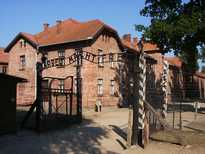
"Arbeit Macht Frei" (Labour Liberates), entry into Auschwitz
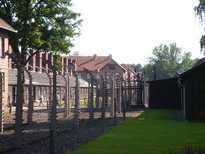
Two high-voltage, barbwired fences had to prevent that people escaped from the camp
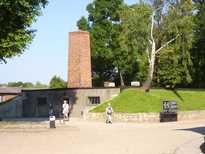
Crematorium in Auschwitz with the mortuary annex gas chamber
Krakow
On Thursday the 8th of July we made a second attempt to visit Krakow. At least the weather looked much more promising than two days before. The sun
shining in a clear blue sky. We followed a tourist route that Kees had given us and after about 2 hours we arrived in Krakow. First we walked to
the Rynek Główny (Main Market Square) where we visited St Mary's Church. A typical example of exaggerated catholic pomp and circumstance,
the choir is dominated by the most important piece of art of the church: The monumental High Altar of Wit Stwosz (Veit Stoss). After the visit to the
church we walked through the Cloth Hall (Sukiennice) from where we walked to the Florianusgate and back through the Florianska street to the main
square and continued towards the Wawel. Until the 17th century the Polish empire was governed from this citadel. We visited the cathedral, the
construction of it started in 1320 after the previous one cathedral was destroyed by fire. We also visited the crypt in which the Polish Royal family
is buried. We also climbed the Zygmunt tower which holds the largest bell of Poland, the Zygmunt (Sigismund) bell, it has a diameter of
2.4 metres and weighs 6 tons. From the cathedral we went down in the Dragon's Den below the Wawel. According the legend once a large fire spitting
dragon lived in this cave. Each week it was fed a large amount of cattle to prevent that it would start eating people. King Krak back then promised that
the one who would defeat the dragon was allowed to marry his daughter. Skuba, a poor cobbler, went to the king. He filled a lamb's fleece with sulphur
and laid it in front of the cave. The dragon ate it and soon after the whole castle shook to its foundations because of the roaring dragon. It went to
the river and drank until it exploded. Then there was a large wedding-feast in the castle for the wedding of the princess and the cobbler. In front of
the Dragon's Den there is a large bronze dragon. From the Wawel we walked back to the Rynek Square to have something to eat before we went back to Kalna.
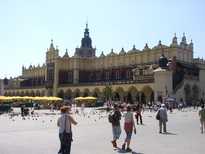
The Cloth Hall on the Rynek Główny in Krakow

St Mary's Church on the Rynek Główny
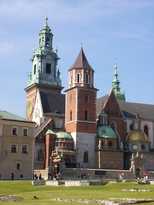
View on the cathedral in the Wawel
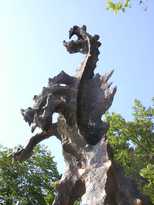
The dragon in front of the Dragon's Den below the Wawel
Bielsko Biała
On our last day in Poland we went to the largest town in the region, Bielsko Biała, not far from Kalna. This day we first had a sleep out, because
the last days we could as we had to get up early because of the long driving times in Poland. Bielsko is not a large city from a tourist point of view,
so after a short time we had seen the most of it. We walked around on the Rynek and admired the house with the frogs (Pod Żabami). Via the castle
and the cathedral (not very interesting) we went to the Weaver's House. This one we also visited, it's an old house with tools that were formerly
used in a weaving-mill. After visiting the weaving-mill we went to a bakery to eat some bread for lunch. Somewhere arounf three in the afternoon we
were back in Kalna. Back home, Ciska helped Gerda with the preparations for dinner this evening, pancakes, normal and Polish ones. The latter ones
contain a sausage and have cheese on them before they are put in an oven. You then eat them with ketchup on them. In the evening Kees and Gerda
had planned to have a camp-fire in the back of the garden, but during dinner it started to rain, so the camp-fire could fall to the ground. But it
was only a short shower, so later that evening, after it had turned dark Kees started the fire and we had really good sausages. Ciska didn't dare
to put her sausage above the fire, so Kees did it for her. We really had a nice evening around the camp-fire in Kalna before we would set off for
Slovakia the next day.
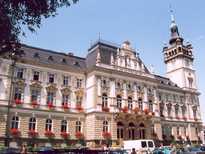
The town hall of Bielsko Biała
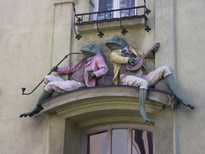
The frog house

The Weaver's House in Bielsko Biała